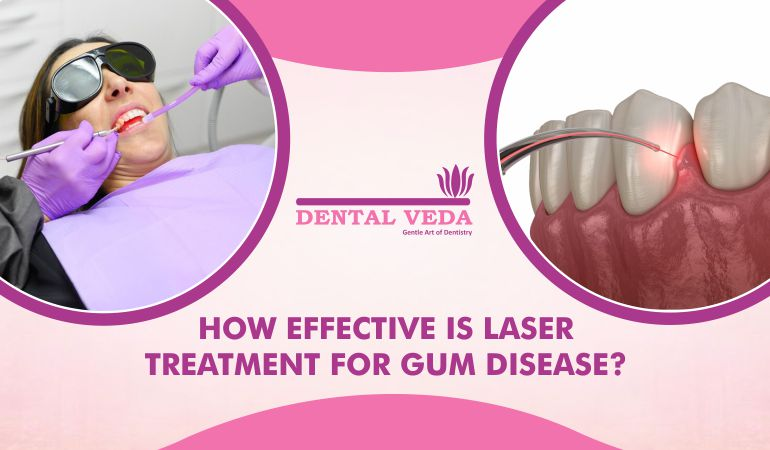Good oral hygiene is essential for the better health of your gums. Periodontal or laser gum treatment is the biggest threat to your dental hygiene.
What exactly does gum disease look like ? As the name implies, gum disease is an infection of the bone tissue that supports your teeth. It occurs when plaque builds up under and along the gum line. This disease is an advanced stage of infection in your gums.
This condition mainly affects adults in their 30s and 40s. A study showed that more than 47% of adults suffer from gum disease. When you neglect your gum health for a long-time, deep pockets can develop between the tissues and bones. The risk factors for periodontal disease include:
-
Poor oral hygiene
-
Smoking
-
Chronic illnesses like diabetes
-
Genetic susceptibility
Typical non-conventional treatment for periodontal disease is scaling and root planing. This non-surgical method includes cleaning the surfaces of teeth and their roots, which may be exposed due to gum recession.
However, laser gum treatment has become more popular in recent years as a treatment for moderate to severe gum disease. As a result, this treatment has become the most beneficial form of gum disease treatment in modern dentistry.
Laser stands for light amplification, which works on stimulated emission of radiation. As opposed to traditional gum surgery, this method uses lasers instead of scalpels.
How does laser gum surgery work?
Lasers are tubes that use powerful, pinpointed light beams of thermal energy, when dentists perform gum surgery. Lasers are helpful in:
-
Cutting and removing diseased tissues
-
Killing germs and bacteria
-
Sterilizing the area
Laser treatment is a tissue-preserving, regenerative procedure. Lasers help to access an infected pocket to kill infected tissues and bacteria in this technique. Once the infected tissue is removed, the ultrasonic root cleaner is used. Then laser energy is used to stimulate the stem cells and create a tissue seal against the tooth root.
The procedure makes sure that no gum tissue is intentionally removed during the gum surgery. During laser surgery, the stem cells in the tissues are used to form new connective tissues and bones.
There are numerous benefits of using laser treatment for gum disease treatment. These benefits include:
Limits bleeding
Many gingivitis patients suffer from severe gum bleeding. Therefore, it becomes critical to removing bacteria. Lasers not only kill the bacteria but also help reduce bleeding and swelling of gums.
Shorter healing time
Laser treatment is ideal to use as it causes little trauma to the gum and surrounding areas. This means healing time is reduced to a great extent as compared to traditional surgery.
Minimally invasive
Laser treatment is less invasive and eliminates the need for drills. This reduces the pressure a patient feels, which means there is little or no need for anesthesia.
Preserves healthy parts of the teeth
Since laser treatments are extremely precise, the technology can be used to preserve the healthy parts of the teeth. For patients who have bacterial infections, preserving healthy teeth will help ensure stronger outcomes in the long run.
Laser treatment uses a laser to access an infected area to destroy bacteria and tissues. This sterilization therapy can effectively be used to handle severe gum problems.
Phases of laser treatment
When treating gum disease, your dentist will mainly go through three phases of treatment. These phases include:
Phase 1: The etiological phase
Treatment in this phase focuses on controlling the infection and restoring the healthy microbiota. Your dentist will look at the root cause of the gum problem.
Procedures like scaling and root planting will happen at this stage. The dentist will clean your teeth and remove plaque and calculus. Medications may also be prescribed at this stage.
Phase 2: The surgical phase
If the conservative treatment isn’t effective, the treatment will move to the surgical phase. This will occur when the infection or plaque is too deep to clean. Surgery may include leveling shallow bone defects or using regenerative techniques for deep bone defects.
Phase 3: The maintenance phase
This phase involves preventing the periodontal disease from returning. Your dentist will detail the oral hygiene practices you need to follow including, brushing your teeth and flossing daily.
At Dental Veda, we use Biolase Company’s Epic X model for advanced laser treatment. The Epic X laser is an all-in-one laser that features software technology and a new cordless foot pedal where you can have access to better surgical treatment. Moreover, with this technology you can have access to pain relief and whitening procedures from a single device.
Post-therapy dental care
Your recovery time and post-therapy dental care will depend on certain factors including, the wavelength used in your laser therapy treatment, the severity of your condition, and medical status. After laser therapy, the healing time will vary from person to person.
Dental Veda: For Best Laser Gum Treatment
At Dental Veda, we work towards providing the best dental treatment in Gurgaon to all the patients. Our dentists have years of experience and skills in the field of dentistry. Count on the team of dentists to provide you with the best personalized dental care.
Book an appointment with us today to restore your healthy smile.
How long does it take for gums to heal after a laser surgery?
The time your gums will take to heal depends on the severity of your gum disease. It generally takes 2-4 weeks to heal after laser therapy. However, deeper pockets can take months to heal completely.
How to take care of your gums after the laser?
After laser treatment, avoid doing aerobic activity for at least 48 hours. Moreover, try to keep your mouth as clean as possible in order to help the healing process.
Do gum tissues grow back?
No receding gums don't grow back. Laser treatment is beneficial to prevent the receding gums from growing and to stop the recession.


